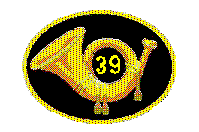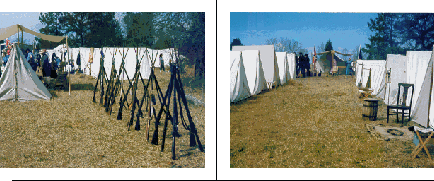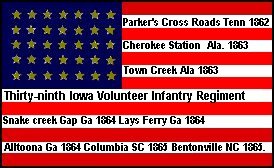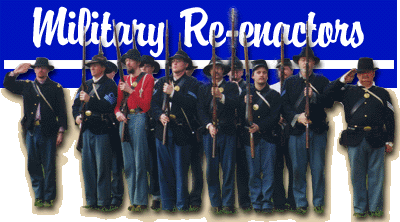First Person
When military camps are open to the public, a quality first person impression will add to their sense of history and result in
positive memories that will last for a long time. However, this can be achieved only by practice and attention to detail.
Physical appearance should reflect actual living conditions and be free from anachronisms, like wristwatches, modern
eyeglasses and cigarettes.
An often overlooked feature is your personal knowledge of political and economic issues, progress of the war and details of
everyday life that civil war soldiers would have known about. This kind of expertise takes some time to accumulate but is
important. It's this kind of information that the public is likely to have and judge you by your accuracy.
Last on the list are the details such as figures of personal speech common to the civil war soldier, or the contents of haversacks
or pockets. Most events are not geared to doing strip searches to see how accurate you are down to your underwear, but you
don't want to pull out Bic lighter, and light a cigarette while convincing a spectator that you're camped there as part of the
defenses around Washington in 1861.


Uniform and Clothes
Having an authentic uniform means acquiring a complete and functional uniform. In addition to the Sack Coat, Trousers, and
Leathers, make sure that shirt and shoes are appropriate to the Civil War era. In addition, most events now include guard
duties and stacking arms, so a bayonet and sheath that actually work with the musket are important and should be included.
Plan on bringing at least one change of shirts, underwear and socks. Socks should be heavy wool types or double pairs of the
light cotton variety. A period style vest is a good idea, especially in cool weather, and is a good place to keep pocket watches,
ear protection and meal tickets.
Other important accessories include a canteen (don't be without one), a poncho and a haversack.
When the temperature drops below 50, seriously consider getting a greatcoat (or a good wool blanket) with gloves and a scarf.
Finally, plan on a complete change of street clothes, especially if getting to the event involves a long car ride.
Rifle and Ammunition
Weekend-long reenactments, with two battles and drill, can use 100 rounds. Plan ahead and bring enough for the whole
weekend. There won't be time to make any. Take enough caps too. Other reenactors don't appreciate someone who always
has to "borrow."
A field cleaning kit for your musket in a small cloth bag is a must. Rifles should be cleaned each night in the field to make sure
they're reliable the next day. The kit should include a small bottle of oil, a cleaning jag, and a rag that can be torn into patches. It
should also include some small squares of bicycle inner-tube to plug the nipple along with a spare nipple, a nipple wrench, and a
nipple pick. Some reenactors have acquired collapsible cleaning rods that can fit into a haversack.
Finally, state law requires firearms to be transported by car in a secure carrying case. It should be long enough for the
rifle-standard cases are too short- and it should tie, zip or buckle shut. In addition to state law, the case is needed to protect the
rifle from travel damage in the car's trunk or back seat.

Rifle Care
At a typical weekend reenactment, a Saturday night cleaning is highly recommended to make sure you can "repel the evil
hoard" on Sunday. Use a field cleaning kit, and do the following:
1. Plug the nipple and fill the barrel with boiling water and rinse. Do this several times until the water runs clear.
2. Remove the plug, point the nipple down, and dry the barrel out with some cloth patches. This step also forces some of the
water out through the nipple to clean out the vent.
3. After the patches come out dry, (it will take a few), oil the inside of the barrel with another patch soaked with oil.
4. Finally, wipe down the stock and metal parts with oil.
Camping Equipment
Even though Civil War troops were issued shelter halves and just rolled up in them on the ground, most reenactors have a
complete tent. This includes two shelter halves (they button together), and two end flaps. It should be water repellent and can
be purchased that way.
While a poncho or gum blanket can be used as a ground cloth, a separate ground cloth is more convenient. It should be
water-proof and free of holes. It should cover the whole tent floor for better, drier storage inside the tent.
Wooden tent pegs are light, cheap and easy to replace. Uprights and ridge poles can be made from any reasonably straight
branches and they should be peeled. They should be no heavier than necessary. It's easier to use straight uprights and lash the
ridgepole in place. Forked uprights are hard do find and tend to split.
For those who can't sleep on straw, or get to events after its gone, backpack or self-inflating mattresses or layers of carpet
padding can be covered by an old sheet sewn into a bag. This, on a ground cloth, with two or three blankets will be warm
enough in most weather.
Another often overlooked item is a travel toilet kit with a personal selection of items like soap, shampoo, toothpaste and brush,
contact lens gear, spare glasses, allergy medicine, prescriptions, aspirin, toilet paper in a water tight pouch, and other items. It
should be small enough to hide in a haversack or small bag.
Things to avoid include chairs and bed frames. Large amounts of tin or ironware were not carried by the Civil War soldier.
Small stools, canvas buckets and lanterns are acceptable. Hatchets are ok for tent pegs, small wooden frame saws are the best
for collecting firewood, especially at large events where firewood is limited.

Camp Setup and Authenticity
Regulations describe a company street arrangement with dog tents along each side with a common cookfire and an officers tent
at one end and the Color Line at the other. This general arrangement is common in reenacting. Individual cookfires are not used
(and weren't used then) and just waste firewood. Occasionally camping is campaign style with no set company streets and an
emphasis on informal shelters. Whatever the case, when you pick your spot, avoid:
anthills,gullies or other obvious rain water collection sites
hillsides
roots and rocks
Police your immediate area incessantly. When a spectator walks through your camp, it blows it when your holding a can of
Coke! Keep all inaccuracies hidden.
Store your rifle hanging from your ridge pole at night. This keeps it out of the way and dry.
Keep spare shirts in your bedroll.
It's easier to put your tent up over your bedding then it is to drag it in there after it's up.
Tie your upright poles to your ridge poles, and keep the open button part of the ridge down, and away from the wind.
Firewood, Water and Straw
At most events, amenities like firewood water and straw end up in short supply chiefly because people take more than they
need. Don't you be one of those. There is no reason to have more firewood than you need so that someone doesn't have
enough, and you have a large supply left over. If you have more wood or straw than you can use, put some back, there is
probably someone who is going without and can use it. In most military camps, one fire per company street. It is a waste to
keep a large fire going all the time, especially if no-one is going to be there, or you are going to bed, besides being dangerous. If
you are the first one at an event, find who's in charge and establish the company street, or join on the existing one if directed.
Start the company fire, if you are your own company that is. Always carry some matches and fire starters.
Water supplies tend to run low especially in hot weather and when water buffaloes are hard to get at. Use only what you need
for cooking, cleaning and drinking. But do not be afraid to drink to much water, remember the "return with an empty canteen"
rule.
Soaking a handkerchief and putting it under your hat, will help keep you cool. Soldiers could also wear a vest instead of their
sack coat, but it is considered improper to be seen in just your shirt and suspenders.
Straw for bedding also runs low. If you take whole bales for yourself, one for your bed, one to sit on, etc., someone will not get
any. Use enough only to make a comfortable bed, and return unused bales to the stockpile.
A final word about porta-jons. Be prepared in case paper runs out. Keep some in a zip-lock baggy or some other
inconspicuous watertight container. Mind your manners, remember that a lot of other people have to use these facilities.
 Food
Even if free meals are promised, or you are told food will be available to purchase, take enough meals and snacks for the whole
weekend. All food should be easy to prepare and easy to clean up. Breakfast, especially, is a meal where it is better to eat in a
hurry before things start to happen. Cornbread and hardtack can be made at home so they're ready to eat. Instant coffee or
fruit drink can be mixed with hot or cold water. Instant oatmeal can be mixed with nuts, coconut, or can be the flavored kind.
Snacks, include peanuts (goober peas), granola bars, and trail mix hidden in a small cloth bag. Fresh fruits and vegetables like
apples, carrots and celery can be carried in a haversack.
For lunch or dinner, potatoes and corn can be cooked in the coals. Soak corn in the husk in water for half an hour first. Hard
boiled eggs can be brought from home or boiled in the fire as can "ramen noodles." Canned hams have more real meat than
bacon, are precooked and have less grease. Slice and cook on a stick or in a skillet.
Avoid the following, because of long preparation time or water intensive cleanup: pancakes, fried potatoes and onions, any raw
meat and most canned foods.
Food
Even if free meals are promised, or you are told food will be available to purchase, take enough meals and snacks for the whole
weekend. All food should be easy to prepare and easy to clean up. Breakfast, especially, is a meal where it is better to eat in a
hurry before things start to happen. Cornbread and hardtack can be made at home so they're ready to eat. Instant coffee or
fruit drink can be mixed with hot or cold water. Instant oatmeal can be mixed with nuts, coconut, or can be the flavored kind.
Snacks, include peanuts (goober peas), granola bars, and trail mix hidden in a small cloth bag. Fresh fruits and vegetables like
apples, carrots and celery can be carried in a haversack.
For lunch or dinner, potatoes and corn can be cooked in the coals. Soak corn in the husk in water for half an hour first. Hard
boiled eggs can be brought from home or boiled in the fire as can "ramen noodles." Canned hams have more real meat than
bacon, are precooked and have less grease. Slice and cook on a stick or in a skillet.
Avoid the following, because of long preparation time or water intensive cleanup: pancakes, fried potatoes and onions, any raw
meat and most canned foods.
 Eating and Drinking
Think of each reenactment as an endurance sports event that lasts for two days. Reenactors face physical exertion, lack of
sleep, climate extremes and constant demands on their attention. All of this means it's important to eat and drink regularly.
Be sure to drink several large tin cups of water each day and bring your canteen back empty from each drill and battle. (The
empty canteen rule). Avoid sweet drinks and alcohol because of the dehydrating effect. If you do not have a canteen, get one.
Usually there's one to borrow, or take some hits from a pard's.
Also be sure to eat at regular intervals. Take your mess kit with whenever you are going to eat. You never know if dishes will
be provided, and you must eat. Do not ignore body signs. Get plenty of fruits and vegetables, as well as grains. Avoid salty
food of any kind. Most events are not bound to eating only authentic meals and foods. Several events offer pancake breakfasts
and the like, so take advantage of these offers. A lot of people work hard to bring these amenities, our taking part shows our
appreciation.
Eating and Drinking
Think of each reenactment as an endurance sports event that lasts for two days. Reenactors face physical exertion, lack of
sleep, climate extremes and constant demands on their attention. All of this means it's important to eat and drink regularly.
Be sure to drink several large tin cups of water each day and bring your canteen back empty from each drill and battle. (The
empty canteen rule). Avoid sweet drinks and alcohol because of the dehydrating effect. If you do not have a canteen, get one.
Usually there's one to borrow, or take some hits from a pard's.
Also be sure to eat at regular intervals. Take your mess kit with whenever you are going to eat. You never know if dishes will
be provided, and you must eat. Do not ignore body signs. Get plenty of fruits and vegetables, as well as grains. Avoid salty
food of any kind. Most events are not bound to eating only authentic meals and foods. Several events offer pancake breakfasts
and the like, so take advantage of these offers. A lot of people work hard to bring these amenities, our taking part shows our
appreciation.

Sutlers' Row and Civilian or Modern Camping
Most reenactors don't spend the whole weekend in military camp and most events schedules allow for some personal time.
Before leaving camp, give some thought to what might take place while you're gone. There are a few things that you should
always plan to be in camp for, including: All drills, inspections, parades and roll calls. If your company has orders for guard
duty or other military chores, you should plan on being available to do your share. The company commander or First Sergeant
should know when you will be needed. It' also a good idea to carry an appropriate timepiece during guard duty. Obviously,
no-one can tell you not to leave camp, but some of the most amazing time-transforming events happen at unexpected times right
in camp.
Reenactors that stay with their families in civilian camp, modern camp or motels have their work cut out for them. It takes
special dedication to spend the right amount of time with your company to be there for military duties, and to keep mom and
the kids from feeling neglected.
One more point about modern camping. This term is used loosely in the reenactment hobby. This usually means wherever you
park, is where you camp. The facilities available are 95% of the time near the reenactors only. Modern camping, unless totally
self contained, can be very difficult.
Post Event Cleanup (when you get home)

One of the most important things to do after any event is putting things away ready to go for the next event. Take special care
to clean and preserve the rifle, especially the barrel, the bore and the percussion cone. Remove all visible rust and wipe lightly
with oil or other preservative. At least once a year, disassemble and inspect all the major assemblies and stock. Renew the
stock finish and remove all rust.
Dry clean or wash uniform items, shirts, socks and vests. Cold water wash in Woolite followed by drip dry is acceptable for
wool items. Even if they appear to be clean, uniforms should be cleaned every two or three events.
Leather items, including boots, should be cleaned of visible dirt. If they've gotten wet, they should be coated with Neetsfoot Oil
or other preservative. This is also the time to fill cap and cartridge boxes and to make more rounds if the supply is getting low.
Finally, metal items such as cooking gear and even the bayonet, should be dried, washed and any rust removed with steel wool.
Be careful not to rub through the outer layer of galvanizing in your cookware, this would leave the bare tin underneath to rust
very quickly. Canteens can be dried out by pushing a long thin strip of rag into the bottom and hang it upside down. Replace
the rag strip when it becomes soaked.
IOWA COUNTIES WEB PAGE( read about Iowa in the Civil War!!!
CLICK HERE TO JOIN OUR CIVIL WAR ROUNDTABLE FORUM AND VOICE YOUR OPNION
Click here to learn more about the 39thIowa Infantry reenacting club.


Email: captjoejoe@uswest.net











